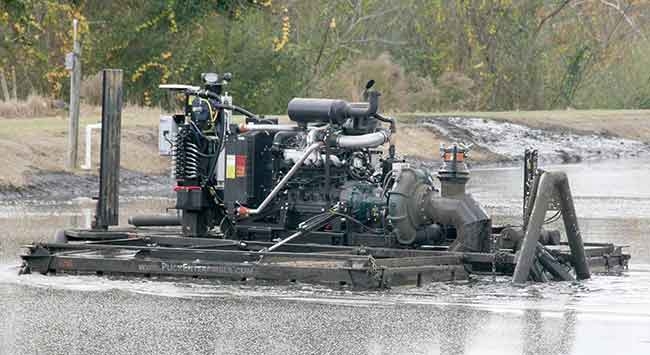
Features
Applications
Dairy
Equipment
Manure Application
Manure Management
Research
Agitation boats can be used to help dairymen recycle waste
March 11, 2016 by Clint Thompson
 An agitation boat is shown during a demonstration at the Manure Field Day held at the UGA Tifton Campus Dairy. Photo courtesy of Clint Thompson/UGA
An agitation boat is shown during a demonstration at the Manure Field Day held at the UGA Tifton Campus Dairy. Photo courtesy of Clint Thompson/UGA
Remote-controlled boats could be a valuable tool for helping dairymen recycle waste on their farms, according to University of Georgia (UGA) scientists.
Every day, dairy farmers must clean and maintain cattle barns, which includes washing out the manure that accumulates daily. This manure is sent to a lagoon located on-site, where it is stored before it is spread on fields as fertilizer.
Over time, solids in the waste settle to the bottom of the lagoon. This waste cannot be used as nutrient-rich fertilizer if the lagoon isn’t stirred or agitated periodically. The remote-controlled boats contain high-volume pumps that can stir up that water before it’s transferred to a field.
“The agitation boats can suspend the solid manure at the bottom of your lagoon up into the liquid, so you can get the nutrients that are stored in the bottom of your lagoon up into suspension and delivered out onto your soils,” says Melony Wilson, a UGA animal waste management specialist based in Athens, Ga.
She says a properly maintained lagoon is designed to accumulate solids for five to 10 years before agitation. Farmers need to agitate the solids from the bottom in order to achieve better success with their lagoon and to increase storage capacity.
“When the solids build up, you lose your storage capacity. Once you’re losing your storage capacity, you have to go in and get those solids stirred up and get them out of your lagoon,” she says.
UGA animal and dairy scientist John Bernard says agitation boats are more effective at stirring up solids at the bottom of lagoons than standard static pumps.
“These boats will get out to all areas of the lagoon. They have high-capacity pumps to agitate the solids and get them in suspension. Then, we can pump them out and have a more uniform product when it’s being applied out on land,” Bernard says.
“Our goal with nutrient management is to get those nutrients into the soil profile to grow the crops. It doesn’t do any good to put it out here and let a rainstorm cause the nutrients to run off into the nearest ditch,” Wilson says.
Clint Thompson is a news editor with the University of Georgia College of Agricultural and Environmental Sciences based in Tifton.